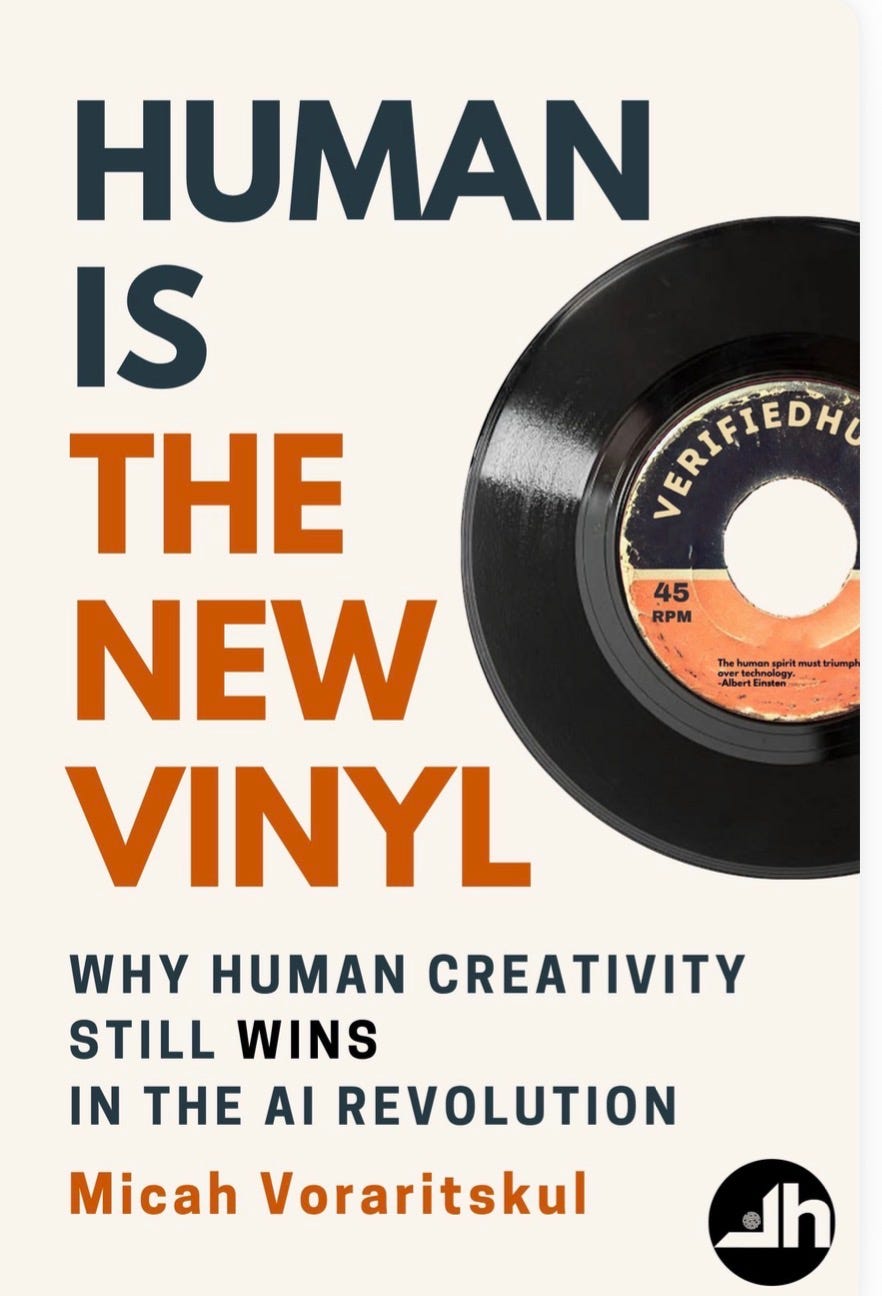Human is the New Vinyl
A Book Review
The Sopranos, Ted Lasso, Seinfeld, Jaws, Star Wars, Dune, The Lord of the Rings, A Love Supreme, Say What, Stan, Nothin' But a G Thang, Fight the Power, Thriller, Smells Like Teen Spirit, The Tortured Poets, The Phantom Tollbooth, Harry Potter, The Joshua Tree, Son of a Sinner, The Scream, The Gospel of John This is a short list of the billions of works that Artificial Intelligence could never create. While it may emulate story and even tone, it cannot draw from the deep and real human experience. Without love, loss, conflict, pain, suffering, angst, or just the feel of rain on your face these stories do not hold the power so very evident within them.
In Human is the New Vinyl, Micah Voraritskul argues for a nuanced and human approach to the imminent use of A.I. within all aspects of life. The book takes us through stages of creation and the ways humans have innovated and responded to technologies in art. From amplification to the enduring recording of sound on vinyl then to digital and the rise of A.I. the first section focuses upon the tools that have shaped us and our art and expression. The balance in this section reveals how humans make decisions about quality and convenience. Like the author, I love the warm and analog sound of vinyl, but I also have an extensive collections of CDs that I both physically own and have as lossless digital files for convenience. But, I understand the differences while also reveling in the art of human experience.
Section two explains how A.I. is moving and affecting the things we make as humans. Art, music, writing, teaching, and other works are being fed into large language models to create artwork that is indistinguishable from the “real” thing. Voraritskul points out how hard it is to discern between A.I. generated art and human art with the exception of improvised jazz. So we jazz lovers can continue in our belief of the superiority of the genre. I kid of course, but it does highlight the limitations of A.I. Which are exposed alongside the possible uses for human creators for tedious tasks or areas that do not change the art. This section contains some of the ethical and environmental challenges with A.I. But Vararitskul gives realistic advice for the use of A.I. as it is becoming more and more difficult to avoid it.
The final section explains how we as humans can win and offers practical advice for creators and those who wish to support the human creative spirit. This is a hopeful volume about the human capacity to adapt and continue creating regardless of the external pressures. The concept of VerifiedHuman™ is introduced as a “hidden track.” This playful nod to the hidden tracks of albums and CDs is the practical path for creatives to label their work as human created. Rather than a locked down luddite style approach, VerifiedHuman™ gives definitions of levels of A.I. aids in creation including the line at which work is considered to be A.I. generated versus human created.
Human is the New Vinyl is an entertaining and fascinating read. I found it engaging and have gone back to sections to tease out more ideas. I joined VerifiedHuman™ as a supporter and can label my own writing as VerifiedHuman™. This review is an example of my work and I hope it does justice to the excellent ideas of the book. I highly recommend this book to creatives and those who support artwork of any kind. As J. aaron Simmons concludes in his Foreward: “Ultimately, it is not the technology that matters. It is the person with whom you speak, think, and laugh. As Micah so effectively shows, humanity is a vinyl record that will never go out of style! Sounds good to me!”




Brandon, what a wonderful and generous review you have written! I can’t thank you enough for the encouragement and the specificity. You have said many things even better than I could have! Cheers, brother.
nice.. maybe we should start a book club